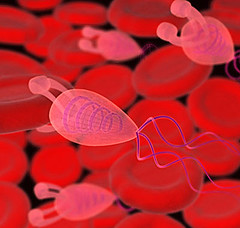Nano-Tech helps stop bleeding
May 12, 2008 by Da-Chief
Filed under Air Force News, Army News, Coast Guard News, Corpsman.com News, Marine Corps News, Military Information, National Guard News, Navy News
A synthetic peptide as discovered by researchers at MIT in the early 90’s. A few years ago they realized this technology could assist with bleeding.. Awesome article, from Technology Review .
Nanohealing Material Heads to Market

|
A startup is planning human trials for a nanostructured material that quickly stops bleeding.
By Kevin Bullis
A startup based in Cambridge, MA, says that it plans to soon begin clinical trials of a nanostructured material that stops bleeding almost instantly. A startup called Arch Therapeutics has licensed the technology from MIT and is developing manufacturing processes for making it in large amounts.
The new material can be poured over a site and will stop the bleeding almost at once.
The first application, pending Food and Drug Administration approval, will be for use during surgery to quickly stop bleeding and even prevent it in the first place. Floyd Loop, currently an advisor to Arch Therapeutics, and formerly a cardiovascular surgeon and the head of Cleveland Clinic, says that it could be useful in a wide variety of surgeries, including brain, heart, and prostate. For example, he says that when large tumors are removed, “there’s a lot of diffuse bleeding around the site, and you have to spend a lot of time with sponges and cautery stopping it.”
Loops says that in addition to saving time, which can improve the outcome of a surgery, the material could decrease the need for transfusions and reoperations to control bleeding. What’s more, it could reduce the risk of infection. It could be used, for instance, to prevent leakage after bowel-repair surgery. “I’ve never seen anything like it,” Loop says.
Eventually, the material could be used by first responders to stop bleeding at accident sites and on the battlefield. It has a long shelf life, which makes it attractive for use in first-aid kits. It’s also easily broken down by the body, so it doesn’t have to be removed, unlike other agents for stopping blood flow. However, Loop cautions that further tests are needed to confirm that the material will work in nonsurgical applications.
The material, a synthetic peptide, was discovered at MIT in the early 1990s. But it wasn’t until a few years ago that its potential for stopping bleeding was discovered. Rutledge Ellis-Behnke, a researcher at MIT’s Department of Brain and Cognitive Sciences, was exploring its potential use to promote the healing of brain injuries. When he applied a liquid containing the synthetic peptides to a wound site in animal experiments, bleeding in the area stopped within a few seconds. Arch Therapeutics was founded in mid-2006 to develop the material for commercial use. The company made its first public appearance late last month when it announced a finalized licensing agreement for the new technology.
Several other compounds have recently been developed to stop bleeding. Fibrin-based products are used in emergency rooms and dental applications, for example, but the new material is faster and more effective, says Steve Yerid, an emergency-room physician at St. Vincent Hospital, in Worcester, MA. Other approaches to stopping bleeding are too slow, can lead to tissue damage, or must be removed from the wound because they don’t readily break down. Conversely, the new material is easy to apply, doesn’t cause damage, and can be left on the wound, even if it’s a deep wound that’s eventually sewn up.
The material consists of naturally occurring amino acids that have been engineered to form peptides that spontaneously cluster together to create long fibers when exposed to salty, aqueous environments, such as those found in the body. The fibers form a mesh that serves as a physical barrier to blood and other fluids.
So far, Arch Therapeutics has been focused on developing new processes for making the materials in large amounts and on developing a better understanding of the mechanisms at work in stopping blood flow. It is preparing to do clinical trials, but is first doing further animal tests. Based on the fact that the material works as a physical barrier, the founders expect that it will qualify as a medical device rather than a drug, which could speed the approval process







